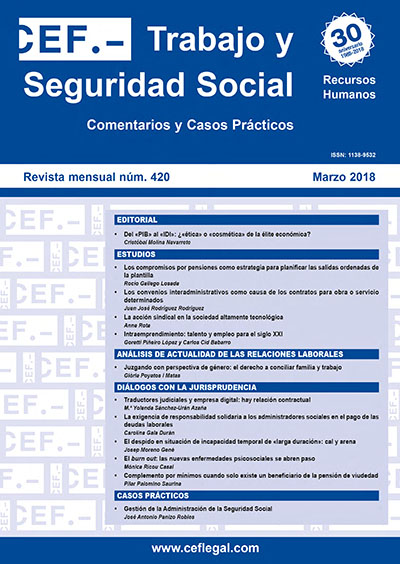Intrapreneurship: talent and employment in the 21st century
DOI:
https://doi.org/10.51302/rtss.2018.1660Keywords:
corporate entrepreneurship, intrapreneurship, threats to employment, business challenges, people managementAbstract
The problem of employment and some of the threats that hover over it constitute the central axis of this work. All this under the light of the whirlwind of technological changes that are making certain professions disappear, while requiring employees to be readjusted for their survival in the 21st century labor market. We have to learn to work and develop people in a VUCA environment, that is, variable, uncertain, complex and ambiguous.
The main idea defended in this study is that the development of entrepreneurship, quality not new in the people, will be crucial to cultivate the necessary talent in companies. In this sense, intrapreneurship, or corporate entrepreneurship, is addressed as the fundamental way to grow entrepreneurial talent within companies. Likewise, it emphasizes the need for continuous training adapted to the new circumstances of the labor market, in order to improve employability in the new times. To new challenges, old solutions. The training, the Corporate Universities, will reinforce their role as a dynamic element in this VUCA business environment of the 21st century in which we are already immersed.
The study provides some experiences of intrapreneurship in Spanish and international companies, with the intention of showing that this activity is taking place in the business sector. Finally, the analysis of the GEM index is addressed, insofar as it is the most relevant index related to the subject matter of analysis. All this based on the studies, reports and queries that appear at the bottom of the page.
Downloads
References
Alcázar, P. (2017). Cómo innovar en negocios tradicionales. emprendedores.es (16-01-2017). Recuperado de http://www.emprendedores.es/gestion/innovacion-negocios-tradicionales (consultado el 30 de abril de 2017).
Andrade, S. (2012). La importancia de los intraemprendedores en las empresas. innovacion.cl (29-08-2012). Recuperado de http://www.innovacion.cl/reportaje/la-importancia-de-los-intraemprendedores-en-las-empresas/ (consultado el 30 de abril de 2017).
Brynjolfsson, E. y McAfee, A. (2011). La carrera contra las máquinas. Boston: Massachusetts Institute of Technology.
Brynjolfsson, E. y McAfee, A. (2014). La segunda era de las máquinas. Boston: Massachusetts Institute of Technology
Cacho Vicente, L. (2013). Lo natural no es que a uno le enseñen, lo natural es que uno aprenda. diariodenavarra.es (16-06-2013). Recuperado de http://www.diariodenavarra.es/noticias/navarra/mas_navarra/2013/06/16/luis_cacho_vicente_quot_natural_que_uno_ensenen_natural_que_uno_aprenda_quot_121029_2061.html (consultado el 30 de abril de 2017).
Camps, X. (2014). 8 características para identificar a un intraemprendedor. thejazzmusician-xavier.blogspot.com.es (08-07-2014). Recuperado de http://thejazzmusician-xavier.blogspot.com.es/2014/07/8-caracteristicas-para-identificar-un.html#links (consultado el 30 de abril de 2017).
Diccionario de Autoridades-Tomo III (1732). Recuperado de http://web.frl.es/DA.html (consultado el 30 de abril de 2017).
Drucker, P. (2002). Innovación y emprendimiento. New York: Harper Business.
Gavín, A. (2015). 6 características de un buen intraemprendedor. elmiracielos.com ( 05-05-2015). Recuperado de http://www.elmiracielos.com/innovacion/6-caracteristicas-de-un-buen-intraemprendedor/ (consultado el 30 de abril de 2017).
Gómez, J. M., Galiana, D. R., López, D. y León, D. (2011). Empleabilidad 2.0. 3ª Guía de Orientación Universitaria para el Empleo. Elche: Universidad Miguel Hernández de Elche. Recuperado de http://observatorio.umh.es/files/2011/06/2011-empleabilidad-20.pdf (consultado el 30 de abril de 2017).
Informe GEM España 2015. Recuperado de http://www.gem-spain.com/wp-content/uploads/2015/03/Informe-GEM-2015-esafp.pdf (consultado el 30 de abril de 2017).
Kreiser, P. M., Marino, L. D. & Weaver, K. M. (2002). Assessing the psychometric properties of the entrepreneurial orientation scale: a muti-country analysis. Entrepreneurship: Theory and Practice, 26(4), 71-94.
MIT Technology Review (2016). MIT Technology Review presenta las 10 Tecnologías Emergentes 2016. Recuperado de https://www.technologyreview.es/listas/tecnologias-emergentes/2016 (consultado el 30 de abril de 2017).
Peters, T. (2000). 50 claves para hacer de usted una marca. Bilbao: Deusto.
Pinchot, G. (1985). Intrapreneurship. New York: Harper & Row.
Primer Informe Mundial sobre el aprendizaje y la educación de adultos. (2010). Hamburgo: Instituto de la UNESCO para la educación a lo largo de toda la vida. Recuperado de http://unesdoc.unesco.org/images/0018/001894/189407s.pdf (consultado el 30 de abril de 2017).
Rodríguez Ibarra, J. C. (2008). ¿Qué significa innovar? elpais.com (31-05-2008). Recuperado de https://elpais.com/diario/2008/05/31/opinion/1212184804_850215.html (consultado el 30 de abril de 2017).
Rosales, P. (2017). Las doce ataduras de la innovación corporativa. https://inusual.com/ (09-02-2017). Recuperado de https://inusual.com/blog/las-12-ataduras-la-innovacion-corporativa (consultado el 30 de abril de 2017).
Rueda-López, J. J. (2007). La tecnología en la sociedad del siglo XXI. Albores de una nueva revolución industrial. Aposta, Revista de Ciencias Sociales, 32. Recuperado de http://www.apostadigital.com/revistav3/hemeroteca/jjrueda.pdf (consultado el 30 de abril de 2017).
Sánchez de Lara Sorzano, C. (2014). Freelance y Colaboradores, Relación Laboral. Valladolid: Lex Nova.
Say, J. B. (2001). Tratado de economía política. Madrid: Fondo de cultura económica de España.
Schumpeter, J. A. (1957). Teoría del Desenvolvimiento Económico. Madrid: Fondo de cultura económica de España.
Tett, G. (2016). Silo effect. Virago Press Ltd.
Trevinyo-Rodríguez, R. N. (2013). Poderosas INTRAEMPRENDEDORAS & Líderes Intergeneracionales. rntrevinyo.wordpress.com (26-08-2013). Recuperado de https://rntrevinyo.wordpress.com/2013/08/26/poderosas-intraemprendedoras-lideres-intergeneracionales/ (consultado el 30 de abril de 2017).
Vega, J. M. (2016). Intraemprendedores. Reinventa tu empresa con espíritu start-up. Barcelona:Libros de Cabecera. Recuperado de https://librosdecabecera.s3.amazonaws.com/book/94/capitulo-gratis-intraemprendedores-reinventa-tu-empresa-con-espiritu-start-up.pdf (consultado el 30 de abril de 2017).
Vesper, K. H. (1990). New Venture Strategies. Londres: Prentice-Hall.
Yzquierdo Tolsada, M. (1988). La responsabilidad civil del profesional liberal. Madrid: Reus.


















